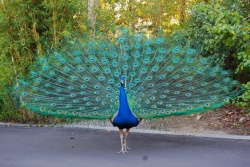Peacock
In a general sense peacocks are a Symbol of openness and acceptance. In Christianity the peacock is a Symbol of immortality. In Mesopotamia appeared a symbolic representation of a tree flanked by two peacocks, which is said to symbolise the dualistic Mind and the absolute unity. In Hinduism the patterns of the peacocks feathers, resembling eyes, symbolise and stars. In Buddhism they symbolise Wisdom.
Peacocks are said to have the ability of eating poisonous plants without being affected by them. Because of that, they are synonymous with the great bodhisattvas. A Bodhisattva is able to take delusions as the path toward Liberation and transform the poisonous Mind of Ignorance, desire and hatred [moha, raga, dvesa] into the Thought of Enlightenment or Bodhicitta, which opens colourfully like the peacocks' tail.
Here we will quote from a teaching called "The WHEEL OF SHARP WEAPONS", written by Dharmaraksita, who passed it to his main Disciple Dipankara Sri Jnana [Atisa, 982-1054].
"In jungles of poisonous plants strut the peacocks,
Through medicine Gardens of Beauty lie near.
The masses of peacocks do not find Gardens pleasant,
But thrive on the essence of poisonous plants,
In similar fashion the brave bodhisattvas
Remain in the jungle of worlds concern.
No matter how joyful this World pleasure garden,
These brave ones are never attracted to pleasures,
But thrive in the jungle of Suffering and pain."
The Mind of the Sentient beings in this World is like a thick forest of desire and hatred. The pleasures and material possessions are like a beautiful medicinal garden. The brave-minded bodhisattvas, because of having realised the shortcomings of Samsara, are not atracted to samsaric pleasures, just as the peacocks are not attracted to medicinal plants. The bodhisattvas, having the attitude of wishing only to work for Sentient beings and not desiring any Happiness for themselves, can utilise the poisonous thoughts of Ignorance, desire, hatred and so forth in order to accomplish the works for Sentient beings.
Bu eating poison, the peacocks' Body becomes healthy and beautiful. He is adorned with five feathers on the head, which symbolise the Five Paths of the boddhisattva and the attainment of the Five Buddha Families. They have beautiful colours, like blue, red, green and please other beings just by being seen. Similarly, any Body who sees a Bodhisattva receives great Happiness in his Mind. The peacock's eating habits of eating poisonous plants do not cause harm to other beings. Similarly the bodhisattvas don not give the slightest harm to any other Sentient beings. By eating poison the colours of his feathers become bright and his Body healthy. Similarly, by taking all problems and Suffering upon themselves, the bodhisattvas quickly purify the Mental obscurations and develop their Mind quickly, attaining higher and higher realization. Particularly peacocks symbolise the transmutting of desire into the path of Liberation. Therefor they are the vehicle of Buddha Amitabha, who represents desire and Attachment transmuted into the Wisdom of Discriminating Awareness.
